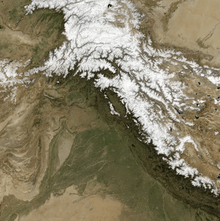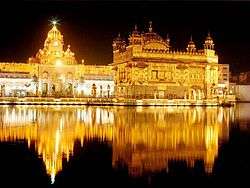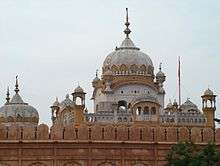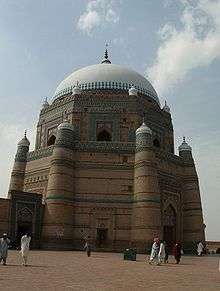Punjab (region)
| Punjab Region | |
<div style="position:relative; margin:0; border-collapse:collapse; border=;"1" cellpadding="0">
_with_cities.png) | |
| Largest Cities | Delhi Lahore Faisalabad |
| Countries |
|
| Official languages | |
| Area | 445,007 km2 (171,818 sq mi) |
| Population (2011) | ~200 million |
| Density | 449/km2 |
| Religions | |
| Demonym | Punjabi |
The Punjab (![]() i/ˈpʌndʒɑːb/ or /ˈpʌndʒæb/), also spelled Panjab, panj-āb, "five rivers"[1]
(Punjabi: پنجاب (Shahmukhi), ਪੰਜਾਬ (Gurumukhi), Hindi: पंजाब (Devanagari)), is a geographical region in one of the northernmost parts of the Indian subcontinent or South Asia, comprising areas of eastern Pakistan and northern India.
i/ˈpʌndʒɑːb/ or /ˈpʌndʒæb/), also spelled Panjab, panj-āb, "five rivers"[1]
(Punjabi: پنجاب (Shahmukhi), ਪੰਜਾਬ (Gurumukhi), Hindi: पंजाब (Devanagari)), is a geographical region in one of the northernmost parts of the Indian subcontinent or South Asia, comprising areas of eastern Pakistan and northern India.
It has been inhabited by Indus Valley Civilisation, Indo-Aryan peoples and has seen numerous invasions by the Achaemenid Empire, Greeks, Kushan Empire, Ghaznavids, Timurids, Mughals, Afghans, British and others. The people of the Punjab today are called Punjabis and their principal language is called Punjabi. The main religions of the Punjab region are Islam, Hinduism, and Sikhism. Other religious groups are Christianity, Jainism and Buddhism.
In 1947, with the dissolution of British India, the region was partitioned between India and Pakistan.
In Pakistan, it includes the Punjab province, Islamabad, parts of Azad Kashmir[2] (namely Bhimber and Mirpur) and parts of Khyber Pakhtunkhwa (namely Peshawar[3] known in the Punjab region as Pishore).[4]
In India, it includes Chandigarh, Delhi, Haryana, Himachal Pradesh, Jammu Division,[5][6] Punjab and parts of Rajasthan[7][8][9][10] in particular the Sri Ganganagar and Hanumangarh districts.[11]
Etymology
The name of the region is a compound of two Persian words[1][12] Panj (five) and ab (water) and was introduced to the region by the Turko-Persian conquerors[13] of India and more formally popularised during the Mughal Empire.[14][15] Punjab literally means "(The Land of) Five Waters" referring to the following rivers: the Jhelum, Chenab, Ravi, Sutlej, and Beas.[16] All are tributaries of the Indus River, the Chenab being the largest.
History

The Punjab region of India and Pakistan has a historical and cultural link to Indo-Aryan peoples as well as partially to various indigenous communities. As a result of several invasions from Central Asia and the Middle East, many ethnic groups and religions make up the cultural heritage of the Punjab.
In prehistoric times, one of the earliest known cultures of South Asia, the Indus Valley Civilisation was located in the region.
The epic battles described in the Mahabharata are described as being fought in what is now the present-day State of Haryana and historic Punjab. The Gandharas, Kambojas, Trigartas, Andhra, Pauravas, Bahlikas (Bactrian settlers of the Punjab), Yaudheyas and others sided with the Kauravas in the great battle fought at Kurukshetra.[17] According to Dr Fauja Singh and Dr L. M. Joshi: "There is no doubt that the Kambojas, Daradas, Kaikayas, Andhra, Pauravas, Yaudheyas, Malavas, Saindhavas and Kurus had jointly contributed to the heroic tradition and composite culture of ancient Punjab".[18]

In 326 BCE, Alexander the Great invaded the tip of the Punjab from the north (present-day Khyber Pakhtunkhwa in Pakistan) and defeated King Porus. His armies entered the region via the Hindu Kush in northwest Pakistan and his rule extended up to the city of Sagala (present-day Sialkot in northeast Pakistan). In 305 BCE the area was ruled by the Maurya Empire. In a long line of succeeding rulers of the area, Chandragupta Maurya and Ashoka stand out as the most renowned. The Maurya presence in the area was then consolidated in the Indo-Greek Kingdom in 180 BCE. Menander I Soter "The Saviour" (known as Milinda in Indian sources) is the most renowned leader of the era, he conquered the Punjab and made Sagala the capital of his Empire.[19] Menander carved out a Greek kingdom in the Punjab and ruled the region till his death in 130 B.C.[20] The neighbouring Seleucid Empire rule came to an end around 12 BCE, after several invasions by the Yuezhi and the Scythian people.
In 711–713 CE, 18-year-old Arab Sultan Muhammad bin Qasim of Taif, a city in Saudi Arabia, came by way of the Arabian Sea with Arab troops to defeat Raja Dahir. The Sultan then led his troops to conquer the Sindh and Punjab regions for the Islamic Umayyad Caliphate. Qasim was the first to bring Islam to the region.

During the establishment and consolidation of the Muslim Turkic Mughal Empire prosperity, growth, and relative peace were established. Particularly under the reign of Jahangir. Muslim empires ruled the Punjab for approximately 1000 years. The period was also notable for the emergence of Guru Nanak (1469–1539), the founder of Sikhism.

In 1758, Punjab came under the rule of Marathas who captured the region by defeating Afghan forces of Ahmad Shah Abdali. Abdali's Indian invasion weakened the Maratha influence, but he could not defeat the Sikhs. After the death of Ahmad Shah, the Punjab was freed from the Afghan yoke by Sikhs between 1773 and 1818. At the time of the formation of the Dal Khalsa in 1748 at Amritsar, the Punjab had been divided into 36 areas and 12 separate Sikh principalities, called misl. From this point onward, the beginnings of a Punjabi Sikh Empire emerged. Out of the 36 areas, 22 were united by Maharaja Ranjit Singh. The other 14 accepted British sovereignty. After Ranjit Singh's death, assassinations and internal divisions severely weakened the empire. Six years later the British East India Company was given an excuse to declare war and in 1849, after two Anglo-Sikh wars, the Punjab was annexed by the British.
In the Indian Rebellion of 1857 the Sikh rulers backed the East India Company, providing troops and support,[21] but in Jhelum 35 British soldiers of HM XXIV regiment were killed by the local resistance and in Ludhiana a rebellion was crushed with the assistance of the Punjab chiefs of Nabha and Malerkotla.
The British Raj had political, cultural, philosophical and literary consequences in the Punjab, including the establishment of a new system of education. During the independence movement, many Punjabis played a significant role, including Madan Lal Dhingra, Sukhdev Thapar, Ajit Singh Sandhu, Bhagat Singh, Udham Singh, Kartar Singh Sarabha, Bhai Parmanand, Muhammad Iqbal, Chaudhary Rehmat Ali, and Lala Lajpat Rai.
At the time of partition in 1947, the province was split into East and West Punjab. East Punjab (48%) became part of India, while West Punjab (52%) became part of Pakistan.[22] The Punjab bore the brunt of the civil unrest following the British Raj, with casualties estimated to be in millions.
Physical geography
At the time of the Sikh Empire Punjab covered a large territory – the entire Indus basin and the watershed between the Indus and Gangetic plains. It could be divided into four natural areas:[1]
- the eastern mountainous region including Jammu Division;
- the central plain with its five rivers;
- the north-western region, separated from the central plain by the Salt Range between the Jhelum and the Indus rivers;
- the semi-desert to the south of the Sutlej river.
The formation of the Himalayan Range of mountains to the east and north-east of the Punjab is the result of a collision between the north-moving Indo-Australian Plate and the Eurasian Plate. The plates are still moving together, and the Himalayas are rising by about 5mm per year.
The upper regions are snow-covered the whole year. Lower ranges of hills run parallel to the mountains. The Lower Himalayan Range runs from north of Rawalpindi though Jammu and Kashmir, Himachal Pradesh and further south. The mountains are relatively young, and are eroding rapidly. The Indus and the five rivers of the Punjab have their sources in the mountain range and carry loam, minerals and silt down to the rich alluvial plains, which consequently are very fertile.[23]
Climate

The climate is a factor contributing to the economy of the Punjab. It is not uniform over the whole region, the sections adjacent to the Himalayas receiving heavier rainfall than those at a distance.[24]
There are three main seasons and two transitional periods. During the Hot Season, from about mid April to the end of June, the temperature may reach 49˚C. The Monsoon Season, from July to September, is a period of heavy rainfall, providing water for crops in addition to the supply from canals and irrigation systems. The transitional period after the monsoon is cool and mild, leading to the Winter Season, when the temperature in January falls to 5˚C at night and 12˚C by day. During the transitional period from Winter to the Hot Season sudden hailstorms and heavy showers may occur, causing damage to crops.[25]
People of the Punjab
Ethnic background
Ethnic ancestries of modern Punjabis include a mixture of Indo-Aryan and Indo-Scythian, Semitic ancestries can also be found in lesser numbers. With the advent of Islam, settlers from Turkestan, Afghanistan, and Kashmir have also integrated into the Muslim Punjabi society. However the majority of Punjab is still made up of the Ahirs, Arains, Dalits (mostly Chamars), Gujjars, Jats, Khatris, Tarkhans, Maliks, Brahmins, Bhats and Rajputs.
| ||||||||||||||||||||||||||||||||||||||||||||||||||
Languages

The major language spoken in the Punjab is Punjabi. In the Indian Punjab this is written in the Gurmukhi script. Pakistan uses the Shahmukhi script, that is closer to Urdu script. Hindi, written in the Devanagri script, is used widely in the Indian states of Himanchal Pradesh and Haryana. Several dialects of Punjabi are spoken in the different regions. The Majhi dialect is considered to be textbook Punjabi and is shared by both countries.
Religions
The vast majority of Pakistani Punjabis are Sunni Muslim by faith, but also include large minority faiths mostly Shia Muslim, Ahmadi Muslim and Christians. Sikhism, a religion founded in the late 15th century, is the main religion practised in Indian Punjab. About 60% of the population of the post-1966 Indian Punjab is Sikh, 37% is Hindu, and the rest are Muslims, Christians, and Jains.[26] However, due to large scale migration from Uttar Pradesh, Rajasthan, Bihar, Bengal and Odisha the demographics of Indian Punjab have become more skewed than reported earlier. Indian Punjab contains the holy Sikh city of Amritsar. The states of Haryana and Himachal Pradesh, formerly constituents of the British province of Punjab, are mostly Hindu-majority.
The Punjab was home to several Sufi saints.[27] Sufism is a concept in Islam. Also, Kirpal Singh revered the Sikh Gurus as saints.[28]
- Population trends for major religious groups in the Punjab Province of British India (1881–1941)[29]
| Religious group |
Population % 1881 |
Population % 1891 |
Population % 1901 |
Population % 1911[lower-alpha 1] |
Population % 1921 |
Population % 1931 |
Population % 1941 |
|---|---|---|---|---|---|---|---|
| Islam | 47.6% | 47.8% | 49.6% | 51.1% | 51.1% | 52.4% | 53.2% |
| Hinduism | 43.8% | 43.6% | 41.3% | 35.8% | 35.1% | 30.2% | 29.1% |
| Sikhism | 8.2% | 8.2% | 8.6% | 12.1% | 12.4% | 14.3% | 14.9% |
| Christianity | 0.1% | 0.2% | 0.3% | 0.8% | 1.3% | 1.5% | 1.5% |
| Other religions / No religion | 0.3% | 0.2% | 0.2% | 0.2% | 0.1% | 1.6% | 1.3% |
Punjabi Festivals
Punjabis celebrate the following cultural, seasonal and religious festivals:
Punjabi Clothing
Traditional Punjabi clothing includes the following:
Major cities

.jpg)


| List of major cities in the Punjab | ||||
|---|---|---|---|---|
| Rank | City | State/Province/Territory | Country | Population |
| 1 | Delhi | National Capital Territory of Delhi | India | 11,034,555[30] |
| 2 | Lahore | Punjab | Pakistan | 10,052,000 |
| 3 | Faisalabad | Punjab | Pakistan | 7,480,675 |
| 4 | Peshawar | Khyber Pakhtunkhwa | Pakistan | 4,201,659 |
| 5 | Islamabad | Islamabad Capital Territory | Pakistan | 1,900,000 |
| 6 | Ludhiana | Punjab | India | 1,618,879 |
| 7 | Gurgaon | Haryana | India | 1,514,432 |
| 8 | Sargodha | Punjab | Pakistan | 1,500,000[31] |
| 9 | Abbottabad | Khyber Pakhtunkhwa | Pakistan | 1,430,238 |
| 10 | Faridabad | Haryana | India | 1,414,050 |
| 11 | Rawalpindi | Punjab | Pakistan | 1,406,214 |
| 12 | Multan | Punjab | Pakistan | 1,202,595 |
| 13 | Amritsar | Punjab | India | 1,132,761 |
| 14 | Gujranwala | Punjab | Pakistan | 1,132,509 |
| 15 | Chandigarh | Union Territory of Chandigarh | India | 961,587 |
| 16 | Jalandhar | Punjab | India | 862,196 |
| 17 | Patiala | Punjab | India | 850,987 |
| 18 | Gujrat | Punjab | Pakistan | 738,558 |
| 19 | Jammu | Jammu and Kashmir | India | 657,314 |
| 20 | Panipat | Haryana | India | 442,277 |
Economy
The historical region of Punjab is considered to be one of the most fertile regions on Earth. Both east and west Punjab produce a relatively high proportion of India and Pakistan's food output respectively.
The region has been used for extensive wheat farming, in addition rice, cotton, sugarcane, fruit and vegetables are also grown.
The agricultural output of the Punjab region in Pakistan contributes significantly to Pakistan's GDP. Both Indian and Pakistani Punjab are considered to have the best infrastructure of their respective countries. Indian Punjab has been estimated to be the second richest state in India.[32] Pakistani Punjab produces 68% of Pakistan's food grain production.[33] Its share of Pakistan's GDP has historically ranged from 51.8% to 54.7%.[34]
Called "The Granary of India" or "The Bread Basket of India", Indian Punjab produces 1% of the world's rice, 2% of its wheat, and 2% of its cotton.[35] In 2001, it was recorded that farmers made up 39% of Indian Punjab's workforce.
Timeline
- 3300–1500 BCE: Harappan civilisation
- 1500–1000 BCE: (Rigvedic) Vedic civilisation
- 1000–500 BCE: Middle and late Vedic Period
- 599 BCE: Birth of Mahavira
- 567–487 BCE: Time of Gautama Buddha
- 550 BCE – 600 CE: Buddhism remained prevalent
- 326 BCE: Alexander's Invasion of Punjab
- 322–298 BCE: Chandragupta I, Maurya period
- 273–232 BCE: Reign of Ashoka
- 125–160 BCE: Rise of the Sakas
- 2 BCE: Beginning of Rule of the Sakas
- 45–180: Rule of the Kushans
- 320–550: Gupta Empire
- 500: Hunnic Invasion
- 510–650: Vardhana's Era
- 711–713: Muhammad bin Qasim conquers Sindh and small part of Punjab region
- 713–1200: Rajput states, Kabul Shahi & small Muslim kinddoms
- 1206–1290: Mamluk dynasty established by Mohammad Ghori
- 1290–1320: Khilji dynasty established by Jalal ud din Firuz Khilji
- 1320–1413: Tughlaq dynasty established by Ghiyasuddin Tughlaq
- 1414–1451: Sayyid dynasty established by Khizr Khan
- 1451–1526: Lodhi dynasty established by Bahlul Khan Lodhi
- 1469–1539: Guru Nanak
- 1526–1707: Mughal rule
- 1526–1530: Zaheeruddin Muhammad Babur
- 1530–1540: Nasiruddin Muhammad Humayun
- 1540–1545: Sher Shah Suri of Afghanistan
- 1545–1554: Islam Shah Suri
- 1555–1556: Nasiruddin Muhammad Humayun
- 1556–1556: Hem Chandra Vikramaditya
- 1556–1605: Jalaluddin Muhammad Akbar
- 1605–1627: Nooruddin Muhammad Jahangir
- 1627–1658: Shahaabuddin Muhammad Shah Jahan
- 1658–1707: Mohiuddin Muhammad Aurangzeb Alamgir
- 1539–1675: Period of 8 Sikh Gurus from Guru Angad Dev to Guru Tegh Bahadur
- 1675–1708: Guru Gobind Singh (10th Sikh Guru)
- 1699: Birth of the Khalsa
- 1708–1713: Conquests of Banda Bahadur
- 1722: Birth of Ahmed Shah Durrani, either in Multan in Mughal Empire or Herat in Afghanistan
- 1714–1759: Sikh chiefs (Sardars) war against Afghans & Mughal Governors
- 1739: Invasion by Nader Shah and defeat of weakened Mughal Empire
- 1747–1772: Durrani Empire led by Ahmad Shah Durrani
- 1756–1759: Sikh and Maratha Empire cooperation in the Punjab
- 1761: The Third Battle of Panipat, between the Durrani Empire against the Maratha Empire.
- 1762: 2nd massacre (Ghalughara) from Ahmed Shah's 2nd invasion
- 1765–1801: Rise of the Sikh Misls which gained control of significant swathes of Punjab
- 1801–1839: Sikh Empire also known as Sarkar Khalsa, Rule by Maharaja Ranjit Singh
- 1845–1846: First Anglo-Sikh War
- 1846: Jammu joined with the new state of Jammu and Kashmir
- 1848–1849: Second Anglo-Sikh War
- 1849: Complete annexation of Punjab into British India
- 1849–1947: British rule
- 1901: Peshawar and adjoining districts separated from the Punjab Province
- 1911: Parts of Delhi separated from Punjab Province
- 1947: The Partition of India divided Punjab into two parts. The Eastern part (with two rivers) became the Indian Punjab and the Western part (three rivers) the Pakistan Punjab
- 1966: Indian Punjab divided into three parts: Punjab, Haryana, and Himachal Pradesh
Photo gallery
-
.jpg)
The Mughal era Badshahi Mosque, Lahore
-

The Faiz Mahal, Khairpur
-

The fort at Bathinda
-

The main gate of the Qila Mubarak, Patiala
-
The Golden Temple in Amritsar
-

The Baradari of Ranjit Singh, built in the Hazuri Bagh
-

The Samadhi of Ranjit Singh
-

The Alamgiri Gate built in 1673, is the main entrance to the Lahore Fort
-

The Phuara Chowk (lit. Fountain Crossing) in Patiala
-

The memorial of the Jallianwala Bagh massacre
-

Jalandhar railway station reception block
-

Irrigated land in the Punjab
-

The Shalimar Gardens in Lahore
-

Mohindra College in Patiala at night
-

The Wazir Khan Mosque in Lahore
-
The Hiran Minar in Sheikhupura, a tribute to Jahangir's favourite antelope
-

The tomb of Nur Jahan in Lahore
-

The tomb of Jahangir in Lahore
-

The Noor Mahal (Palace of Light) in Bahawalpur
-

The Jhelum River, one of the major rivers of the Punjab
-

The Open Hand monument in Chandigarh
-

Closer view of Amar Mahal Museum, Jammu
-
Ghainta ghar, Peshawar
-
.jpg)
Dakhni Sarai, Nakodar (gate)
-
Shrine Baba Budda Ji Nakodar
See also
Notes
- ↑ Delhi district is made into a separate territory
References
- 1 2 3 H K Manmohan Siṅgh. "The Punjab". The Encyclopedia of Sikhism, Editor-in-Chief Harbans Singh. Punjabi University, Patiala. Retrieved 18 August 2015.
- ↑ History of Panjab Hill States, Hutchison, Vogel 1933 Mirpur was made a part of Jammu and Kashmir in 1846
- ↑ Changes in the Socio-economic Structures in Rural North-West Pakistan By Mohammad Asif Khan Peshawar was separated from Punjab Province in 1901.
- ↑ Nadiem, Ihsan H. (2007). Peshawar: heritage, history, monuments. Sang-e-Meel Publications. Retrieved 13 September 2015.
- ↑ "Jammu and Kashmir". Encyclopedia Britannica.
- ↑ "Epilogue, Vol 4, Issue 11".
- ↑ The Times Atlas of the World, Concise Edition. London: Times Books. 1995. p. 36. ISBN 0 7230 0718 7.
- ↑ Grewal, J S (2004). Historical Geography of the Punjab (PDF). Punjab Research Group, Volume 11, No 1. Journal of Punjab Studies. pp. 4, 7, 11.
- ↑ see the Punjab Doabs
- ↑ Pritam Singh and Shinder S. Thandi, ed. (1996). Globalisation and the region: explorations in Punjabi identity. Coventry Association for Punjab Studies, Coventry University. p. 361.
- ↑ Balder Raj Nayat (1966). Minority Politcs in the Punjab. Retrieved 13 September 2015.
- ↑ Ghandi, Rajmohan (2013). Punjab: A History from Aurangzeb to Mountbatten. New Delhi, India, Urbana, Illinois: Aleph Book Company. p. 1 ("Introduction"). ISBN 978-93-83064-41-0.
- ↑ Canfield, Robert L. (1991). Turko-Persia in Historical Perspective. Cambridge, United Kingdom: Cambridge University Press. p. 1 ("Origins"). ISBN 978-0-521-52291-5.
- ↑ Ghandi, Rajmohan (2013). Punjab: A History from Aurangzeb to Mountbatten. New Delhi, India, Urbana, Illinois: Aleph Book Company. ISBN 978-93-83064-41-0.
- ↑ Shimmel, Annemarie (2004). The Empire of the Great Mughals: History, Art and Culture. London, United Kingdom: Reaktion Books Ltd. ISBN 1-86189-1857.
- ↑ Encyclopaedia Britannica, 9th ed., vol.20, Punjab, p.107
- ↑ Buddha Parkash, Evolution of Heroic Tradition in Ancient Panjab, p 36.
- ↑ History of Panjab, Vol I, p 4, Dr L. M. Joshi, Dr Fauja Singh.
- 1 2 Hazel, John (2013). Who's Who in the Greek World. Routledge. p. 155. ISBN 9781134802241.
Menander king in India, known locally as Milinda, born at a village named Kalasi near Alasanda (Alexandria-in-the-Caucasus), and who was himself the son of a king. After conquering the Punjab, where he made Sagala his capital, he made an expedition across northern India and visited Patna, the capital of the Mauraya empire, though he did not succeed in conquering this land as he appears to have been overtaken by wars on the north-west frontier with Eucratides.
- 1 2 Ahir, D. C. (1971). Buddhism in the Punjab, Haryana, and Himachal Pradesh. Maha Bodhi Society of India. p. 31. OCLC 1288206.
Demetrius died in 166 B.C., and Apollodotus, who was a near relation of the King died in 161 B.C. After his death, Menander carved out a kingdom in the Punjab. Thus from 161 B.C. onward Menander was the ruler of Punjab till his death in 145 B.C. or 130 B.C..
- ↑ Ganda Singh (August 2004). "The Truth about the Indian Mutiny". Sikh Spectrum. Retrieved 13 March 2013.
- ↑ . Daily Times (10 May 2012). Retrieved on 2013-07-12.
- ↑ G. S. Gosal. "Physical Geography of the Punjab" (PDF). University of California, Santa Barbara. Retrieved 3 November 2012.
- ↑ Maps of India, Climate of Punjab
- ↑ Royal Geographical Society Climate and Landscape of the Punjab
- ↑ "Census Reference Tables, C-Series Population by religious communities". Census of India. 2001. Retrieved 25 July 2010.
- ↑ "Sufi Saints of the Punjab". Punjabics.com. Retrieved January 2015.
- ↑ Kirpal Singh, Sant. "The Punjab - Home of Master Saints". Retrieved January 2015.
- ↑ Gopal Krishan. "Demography of the Punjab (1849-1947)" (PDF). Retrieved 15 October 2015.
- ↑ "List of Most populated cities of India".
- ↑ http://www.urbanunit.gov.pk/PublicationDocs/Punjab%20city%20profiles/Sargodha%20City%20Profile.pdf
- ↑ "Punjab second richest state in country: CII", Times of India, 8 April 2004.
- ↑ Pakistani government statistics, retrieved 14 April 2007.
- ↑ Provincial Accounts of Pakistan: Methodology and Estimates 1973-2000
- ↑ Yadav, Kiran (11 February 2013). "Punjab". Agropedia. Retrieved 15 March 2013.
Further reading
- Narang, K.S.; Gupta, Dr H.R. (1969). History of the Punjab 1500-1858 (PDF). U. C. Kapur & Sons, Delhi. Retrieved 22 January 2014.
- [Quraishee 73] Punjabi Adab De Kahani, Abdul Hafeez Quaraihee, Azeez Book Depot, Lahore, 1973.
- [Chopra 77] Punjab as a Sovereign State, Gulshan Lal Chopra, Al-Biruni, Lahore, 1977.
- Patwant Singh. 1999. The Sikhs. New York: Doubleday. ISBN 0-385-50206-0.
- The Evolution of Heroic Tradition in Ancient Panjab, 1971, Buddha Parkash.
- Social and Political Movements in ancient Panjab, Delhi, 1962, Buddha Parkash.
- History of Porus, Patiala, Buddha Parkash.
- History of the Panjab, Patiala, 1976, Fauja Singh, L. M. Joshi (Ed).
- The Legacy of the Punjab, 1997, R M Chopra.
- The Rise Growth and Decline of Indo-Persian Literature, R M Chopra, 2012, Iran Culture House, New Delhi. 2nd revised edition published in 2013.
- Sims, Holly. "The State and Agricultural Productivity: Continuity versus Change in the Indian and Pakistani Punjabs." Asian Survey, 1 April 1986, Vol.26(4), pp. 483–500
External links
| Wikimedia Commons has media related to Punjab (region). |
- Official website of Punjab, India
- Official website of Punjab, Pakistan
- Punjab, India at DMOZ
- Punjab, Pakistan at DMOZ
| |||||||||||||||||||||||||
| ||||||||||||||||||||||||||||
| ||||||||
| ||||||||||||||
Coordinates: 31°N 74°E / 31°N 74°E
|




